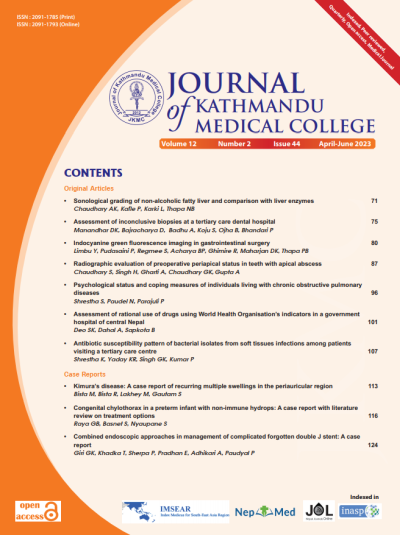Indocyanine green fluorescence imaging in gastrointestinal surgery
DOI:
https://doi.org/10.3126/jkmc.v12i2.45509Keywords:
Anastomotic leak, Indocyanine green, Surgical marginAbstract
Background: Prevention of post-operative anastomotic leak (AL) is significant challenge for surgeons, with roughly half of all AL cases linked to insufficient vascular supply, often undetectable during anastomosis. Recently, indocyanine green fluorescence (ICG) emerged as promising tool in visceral surgery due to its low cost, ease of use, wide availability, and low toxicity. In gastrointestinal surgery, ICG is primarily used for real-time intraoperative angiography, allowing surgeons to assess anastomotic stumps' perfusion before and after procedure.
Objectives: To assess efficacy of ICG as an adjunct in preventing AL.
Methods: This descriptive study conducted after ethical approval at Kathmandu Medical College Teaching Hospital from 2022 February 15 to 2023 January 30 included 111 patients enrolled via convenience sampling. During operation, surgeon used ICG fluorescence angiography on patients to determine perfusion status, which allowed for evaluation of transection line and post-anastomotic viability. Data were entered in Microsoft Excel sheet 2019 and descriptive analysis done regarding demographic data, changes in the transection line, and post-operative anastomotic leaks.
Results: Total 111 patients with age 55.41 ± 13.63 years and male-female ratio of 2:1 participated in this study. ICG use resulted in changes to proximal resection margin for five (4.5%) patients. Clinical judgment and ICG fluorescence imaging showed a difference in bowel transection line of 0.5-1.5 cm. None of the patients who underwent proximal resection margin revision with the assistance of ICG experienced post-operative anastomotic leaks.
Conclusion: ICG fluorescence can be used as an adjunct in determining the viability of anastomosis and prevent post-operative anastomosis leak.
Downloads
Downloads
Published
How to Cite
Issue
Section
License
Copyright (c) 2023 Journal of Kathmandu Medical College

This work is licensed under a Creative Commons Attribution-NonCommercial 4.0 International License.
Copyright © Journal of Kathmandu Medical College
The ideas and opinions expressed by authors or articles summarized, quoted, or published in full text in this journal represent only the opinions of the authors and do not necessarily reflect the official policy of Journal of Kathmandu Medical College or the institute with which the author(s) is/are affiliated, unless so specified.
Authors convey all copyright ownership, including any and all rights incidental thereto, exclusively to JKMC, in the event that such work is published by JKMC. JKMC shall own the work, including 1) copyright; 2) the right to grant permission to republish the article in whole or in part, with or without fee; 3) the right to produce preprints or reprints and translate into languages other than English for sale or free distribution; and 4) the right to republish the work in a collection of articles in any other mechanical or electronic format.




